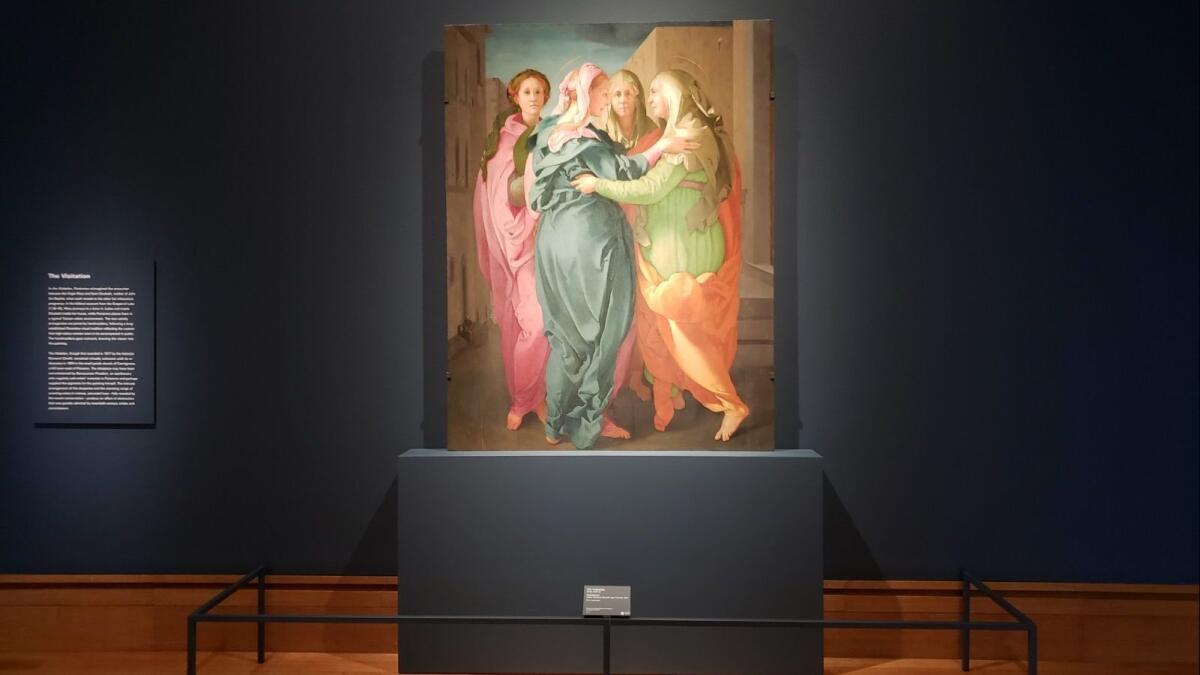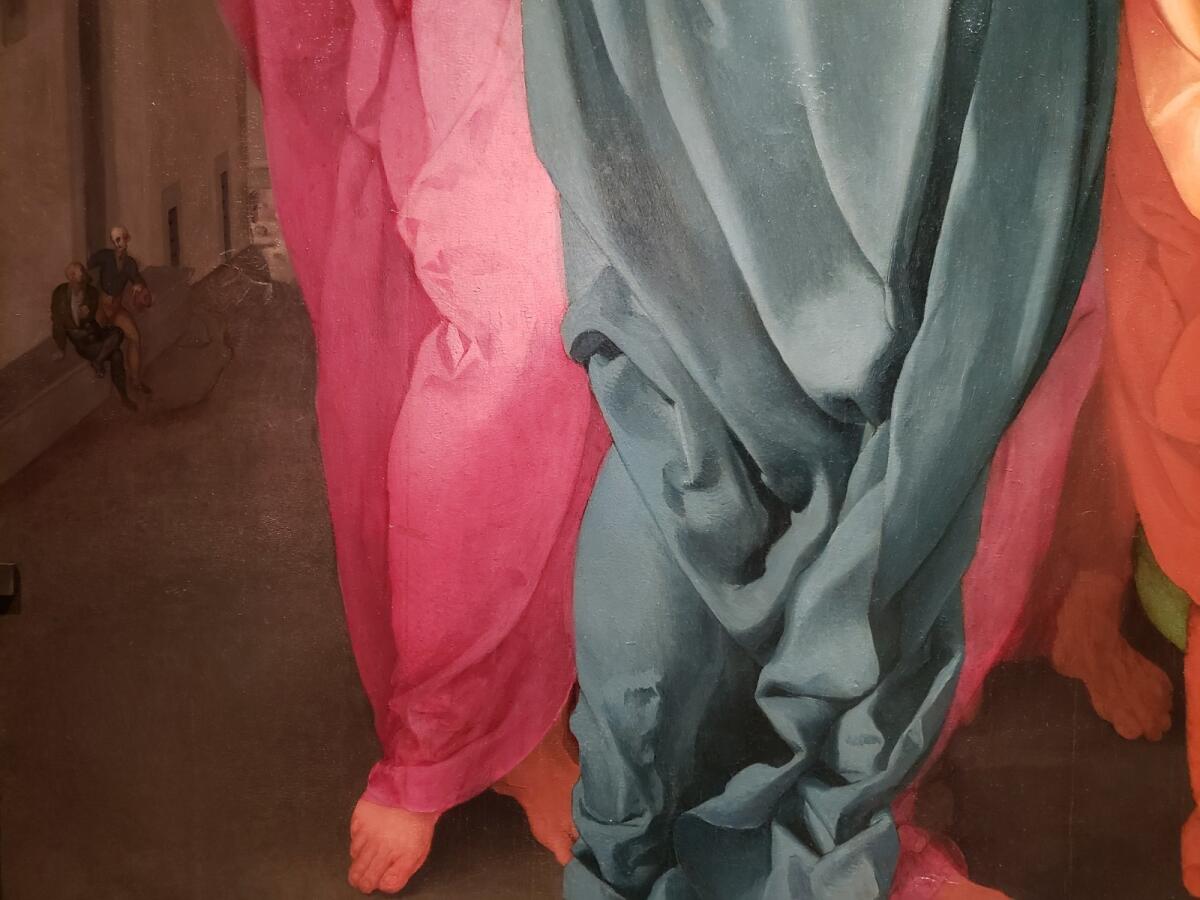Review: Pontormo’s ‘Visitation,’ a Renaissance masterpiece of extreme imagination, visits the Getty

- Share via
Jacopo Pontormo is among the strangest artists to have emerged from the Florentine Renaissance, a painter for whom nothing is poised and direct and everything seems on edge. There’s no one like him — not even his star pupil, Agnolo Bronzino, whose elegant iciness is anything but restless.
Spend some time with his large and spellbinding altarpiece, “The Visitation,” and the artist’s extravagant but peculiar gifts unfold. Turns out Pontormo’s odd because he’s radically distinctive — visionary and inventive.
The monumental panel painting — it’s oil on poplar wood — has never before traveled outside Italy. For centuries it has been housed in a small church in Carmignano, a sleepy hill-town about a dozen miles west of Florence, but currently “The Visitation” is visiting the J. Paul Getty Museum.
Pontormo’s greatest portrait painting, “Portrait of a Halberdier (Francesco Guardi?),” is enjoying its 30th anniversary as one of the Getty’s matchless treasures. For the next 10 weeks it is joined by the altarpiece, along with a second handsome Pontormo portrait of a young soldier and four drawings by the artist: a self-portrait plus studies for the “Halberdier,” “The Visitation” and another soldier portrait.

Three more objects complete the focus show, which was co-organized by Getty curator Davide Gasparotto and Bruce Edelstein, coordinator for graduate programs at New York University in Florence. They add further context for the riveting main event.
The figural composition in a 1497 Albrecht Dürer engraving is similar to “The Visitation.” A 1568 second edition of Giorgio Vasari’s groundbreaking book, “Lives of the Most Excellent Painters, Sculptors and Architects,” is opened to a woodcut portrait of a rather hangdog Pontormo. And, finally, a painting of Pygmalion — a Greek mythological figure whose sculpture of a woman came to miraculous life, first shown last fall in the museum’s magnificent exhibition, “The Renaissance Nude” — was done by the younger Bronzino, whom Pontormo adopted as an adult.
All the paintings and drawings are dated between 1528 and 1530, when Pontormo was in his mid-30s. A lengthy and tumultuous siege that finally overthrew the Florentine Republic, returning the city to dynastic Medici rule, partly explains the edginess in his work (not to mention the frequency of soldiers). But there’s more to it than destabilized politics.
“The Visitation,” looking fresh as a daisy after extensive recent conservation, shows the young Virgin Mary greeting the elderly St. Elizabeth at the top of a steep urban street. Florentine social protocol demanded that a woman of importance not be out and about in public unattended, so a handmaiden accompanies each; the two servants’ age difference roughly corresponds to that of the two saints.
Mary and Elizabeth reach out in a tender embrace. No wonder: The young virgin is pregnant — impossible but true — while the elderly woman (some calculate that she’s in her 80s) is likewise expecting, with John the Baptist. It’s a miraculous double-whammy.
They lock eyes, linking the astounding news that the visit has been arranged to share. Many Renaissance artists painted the subject, but the brilliance of Pontormo’s version lies in the unique ways in which he endowed an orthodox depiction with its own sheer miraculousness.
The handmaidens stare straight ahead, stonily connecting this incredible and otherwise inexplicable event to viewers, who stare back at the painting. The heads and eyes of all four women line up across the picture in a nearly straight row.
This arrangement likely comes from ancient Roman relief carvings, but it has a marvelous effect. No hierarchy is asserted between saints and servants — or, by extension, between them and us — so our perception becomes part of their vivid interaction.
Seeing is believing, one might say of the eyeball roundelay. All this visual complexity is pitched straight at a viewer, who can’t help but feel surreptitiously favored by the attention.
DESERT X: Ailing bighorn sheep put Jenny Holzer project on hold »
Pontormo exploits two more clever, if slightly surreptitious, compositional devices to achieve the full effect.
First, the illusionistic light source that illuminates the scene seems to come from behind us, the viewers, over our left shoulder. We’re subtly enfolded into the warm, virtual glow of Pontormo’s saturated, jewel-tone colors — luminous robes painted in big swaths of hot pink, royal blue, fierce orange and deep emerald, sage and lime green. Cinnabar highlights blaze.
Second, the voluptuous softness of the women’s curvilinear shapes is paradoxically arranged into a rectilinear composition, with each woman’s head located at the corner of a visual box.
Scholars have long surmised that this unusual rectangular arrangement derives from “Four Naked Women,” the widely distributed, very popular Dürer engraving on view. There’s no reason to disagree. But I also think there’s one big difference.
Dürer’s women are contained within an interior. Pontormo’s aren’t.
His four women aren’t just outdoors, either. Instead, they are purposefully set between two big buildings — rectilinear boxes whose sharp perspective thrusts them out toward a viewer, like spokes on a wheel. The boxy rectilinear composition of the women fits right in between them, making the women inseparable from the public setting.
Dürer’s women are private, enclosed within a cloistered room. Pontormo’s broadcast themselves outward into communal space. The artist trumpets their world-changing news, endowing the miracle with huge public import.
He even exaggerates the outward thrust in quirky and distinctive ways. Look closely at the lower left, next to the tall, hot-pink attendant’s knee: There, a tiny pair of men are seated on a low wall, doing nothing much in particular.

MORE ART: Hollywood takes a ‘Velvet Buzzsaw’ to the art critic »
Yet, the implied distance of the tiny men is positively vertiginous. The painting, raised onto an altar, locates them around a viewer’s eye-level. They’re important: The adjacent women, already just over life-size, loom even larger.
And look closer still beyond the two idle men, down at the end of the city street where a small piazza opens up. An incongruous donkey peeks its hee-haw head around the corner, looking back at you.
“Fear not, daughter of Zion,” says the Gospel of John. “Behold, your King is coming, sitting on a donkey’s colt.”
“The Visitation” between Mary and Elizabeth is an extravagant herald of Christ’s coming — bold in composition, touching in its empathetic figures and ecstatic in coloration. Even that teeny, barely glimpsed little animal off in the distance plays a part in the shattering mystery of the incarnation.
Who but Pontormo would do that?
An unorthodox 23-page diary the artist wrote three decades later, in the months before his death at 63 in 1557, reveals a lonely recluse obsessively trying to manage his melancholy by recording, line after line, every bit of food eaten, twinge of illness felt, slight change in weather endured — even every daily bowel movement taken. Friends drop by, but he hides from them.
Long cited as evidence for Pontormo’s personal weirdness, the diary is now described by Rutgers University art historian Elizabeth Pilliod as an indication of a common 16th-century urge: The aging painter was keeping fit, his goal to remain attuned to the inspiration essential to his deeply felt artistic calling.
Pilliod, one of eight contributors to the show’s fine catalog, has been instrumental in normalizing Pontormo’s reputation, long-skewed as kooky. “The Visitation” reveals itself as a masterpiece most artists simply could not manage — imaginative in the extreme.
♦ ♦ ♦ ♦ ♦ ♦ ♦ ♦ ♦ ♦
‘Pontormo: Miraculous Encounters’
Where: J. Paul Getty Museum, 1200 Getty Center Drive, Brentwood
When: Through April 28; closed Mondays
Info: (310) 440-7330, getty.edu
More to Read
The biggest entertainment stories
Get our big stories about Hollywood, film, television, music, arts, culture and more right in your inbox as soon as they publish.
You may occasionally receive promotional content from the Los Angeles Times.











